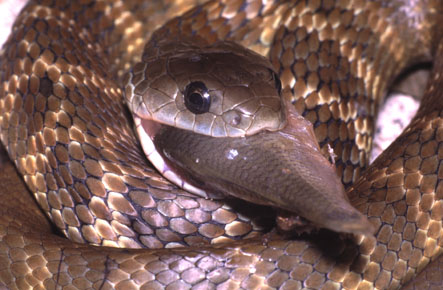 EASTERN TIGER SNAKE Notechis scutatus (Peters, 1861)
EASTERN TIGER SNAKE Notechis scutatus (Peters, 1861)
The Eastern Tiger Snake is highly variable in colour, ranging from olives, yellows, browns, reddish, greys or even black, with or without
cross bands of varying intensity. This 1.3 metre snake is highly dangerous, and has claimed the lives of more white Australians in the last 200 years than any other type of snake. It is found throughout south east Australia, except in very arid places, and areas where the Black Tiger
Snake Notechis ater occurs.
The scalation is smooth with 15-19 mid body rows, 146-185 ventrals, single anal, and 39-65 single subcaudals.
The Eastern Tiger Snake is only aggressive when agitated and when aroused will flatten its' neck and body, and lunge forward in various directions, striking when possible. Although the Eastern Tiger Snake will occupy a variety of habitats, in hotter and drier places it tends to be found in the vicinity of water, or on floodplains. It is most common in sandy and swampy locations.
Although usually diurnal, the Eastern Tiger snake may become nocturnal in warm weather, particularly juveniles. Most Eastern Tiger Snakes are caught during the day, either foraging or under loose ground cover. Diet is varied, but includes most types of small vertebrate, particularly
frogs.  The Cane Toad Bufo marinus is exterminating this snake in Queensland and parts of NSW.
The Cane Toad Bufo marinus is exterminating this snake in Queensland and parts of NSW.
Mating occurs in early spring with 17-109 (average 35) live young being produced in late summer. Young when born measure about 18 cm, and often have distinct thick, brown and yellow bands which fade in later life.
The above was from the book Australian Reptiles and Frogs by Raymond Hoser and now available on a fantastic CD-Rom along with a vast amount of other information, papers and the like on reptiles, frogs and other wildlife.